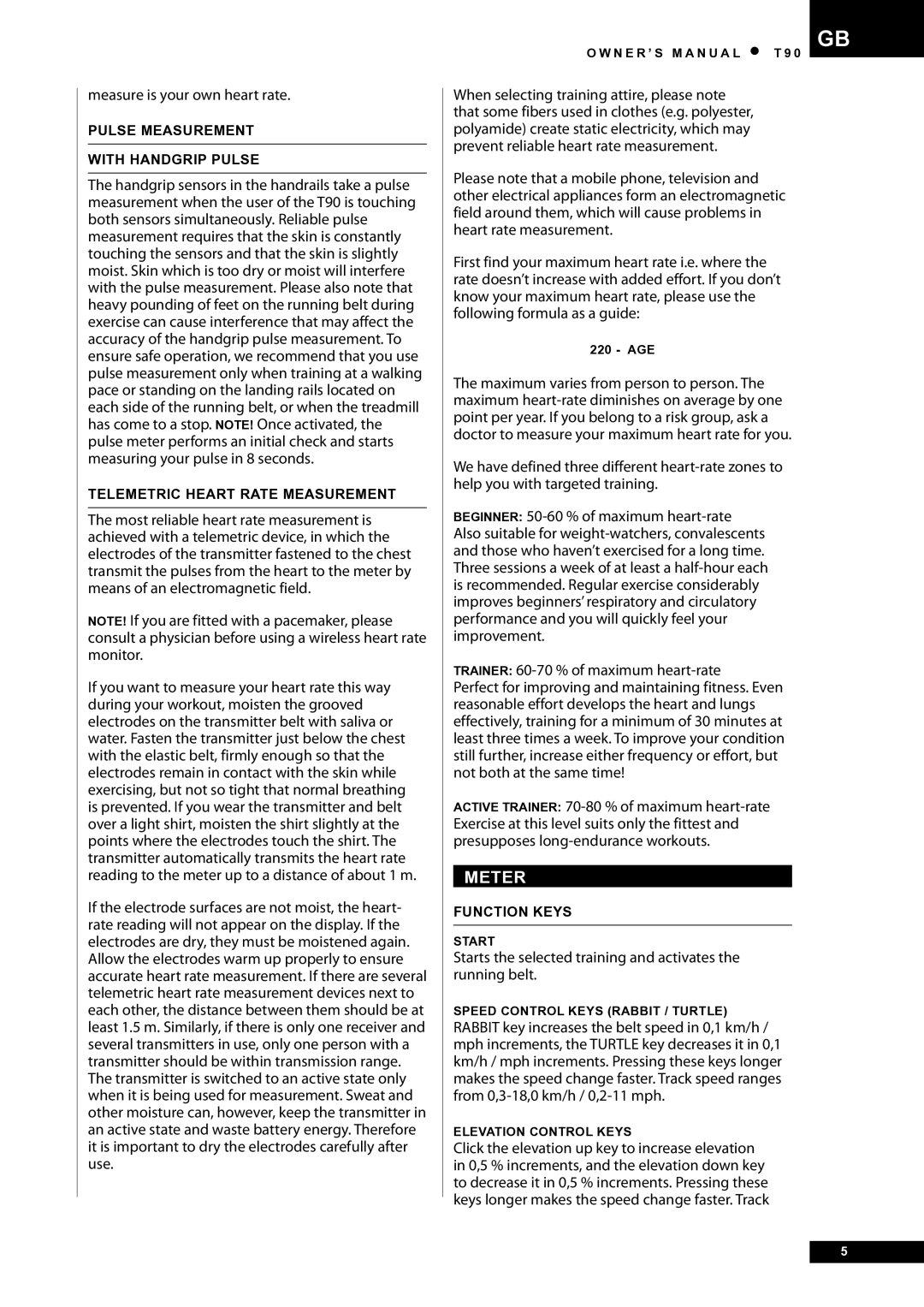
measure is your own heart rate.
PULSE MEASUREMENT
WITH HANDGRIP PULSE
The handgrip sensors in the handrails take a pulse measurement when the user of the T90 is touching both sensors simultaneously. Reliable pulse measurement requires that the skin is constantly touching the sensors and that the skin is slightly moist. Skin which is too dry or moist will interfere with the pulse measurement. Please also note that heavy pounding of feet on the running belt during exercise can cause interference that may affect the accuracy of the handgrip pulse measurement. To ensure safe operation, we recommend that you use pulse measurement only when training at a walking pace or standing on the landing rails located on each side of the running belt, or when the treadmill has come to a stop. NOTE! Once activated, the pulse meter performs an initial check and starts measuring your pulse in 8 seconds.
Telemetric heart rate measurement
The most reliable heart rate measurement is achieved with a telemetric device, in which the electrodes of the transmitter fastened to the chest transmit the pulses from the heart to the meter by means of an electromagnetic field.
NOTE! If you are fitted with a pacemaker, please consult a physician before using a wireless heart rate monitor.
If you want to measure your heart rate this way during your workout, moisten the grooved electrodes on the transmitter belt with saliva or water. Fasten the transmitter just below the chest with the elastic belt, firmly enough so that the electrodes remain in contact with the skin while exercising, but not so tight that normal breathing is prevented. If you wear the transmitter and belt over a light shirt, moisten the shirt slightly at the points where the electrodes touch the shirt. The transmitter automatically transmits the heart rate reading to the meter up to a distance of about 1 m.
If the electrode surfaces are not moist, the heart- rate reading will not appear on the display. If the electrodes are dry, they must be moistened again. Allow the electrodes warm up properly to ensure accurate heart rate measurement. If there are several telemetric heart rate measurement devices next to each other, the distance between them should be at least 1.5 m. Similarly, if there is only one receiver and several transmitters in use, only one person with a transmitter should be within transmission range. The transmitter is switched to an active state only when it is being used for measurement. Sweat and other moisture can, however, keep the transmitter in an active state and waste battery energy. Therefore it is important to dry the electrodes carefully after use.
O w n e r ’ s m a n u a l • T 9 0
When selecting training attire, please note that some fibers used in clothes (e.g. polyester, polyamide) create static electricity, which may prevent reliable heart rate measurement.
Please note that a mobile phone, television and other electrical appliances form an electromagnetic field around them, which will cause problems in heart rate measurement.
First find your maximum heart rate i.e. where the rate doesn’t increase with added effort. If you don’t know your maximum heart rate, please use the following formula as a guide:
220 - AGE
The maximum varies from person to person. The maximum
We have defined three different
BEGINNER:
TRAINER:
Perfect for improving and maintaining fitness. Even reasonable effort develops the heart and lungs effectively, training for a minimum of 30 minutes at least three times a week. To improve your condition still further, increase either frequency or effort, but not both at the same time!
ACTIVE TRAINER:
METER
FUNCTION KEYS
START
Starts the selected training and activates the running belt.
SPEED CONTROL KEYS (RABBIT / TURTLE)
RABBIT key increases the belt speed in 0,1 km/h / mph increments, the TURTLE key decreases it in 0,1 km/h / mph increments. Pressing these keys longer makes the speed change faster. Track speed ranges from
ELEVATION CONTROL KEYS
Click the elevation up key to increase elevation in 0,5 % increments, and the elevation down key to decrease it in 0,5 % increments. Pressing these keys longer makes the speed change faster. Track
GB
5
